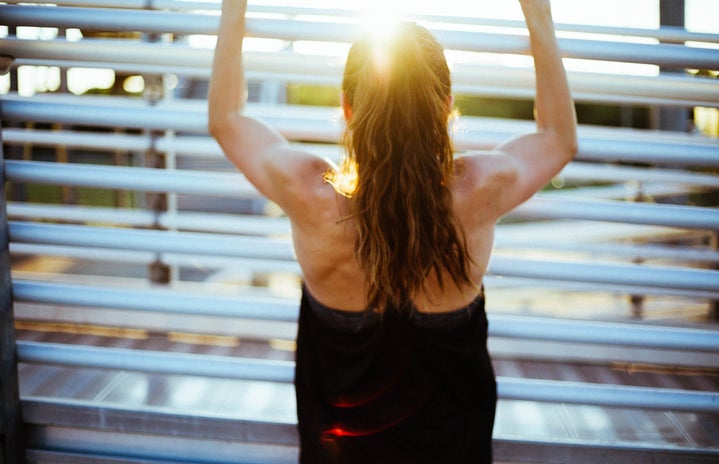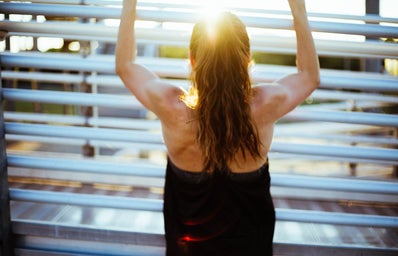If you’ve read my column before, you know that I take my job very seriously. A yoga instructor may just seem like a fitness-oriented job, but it’s a lot more intimate. It’s my job to make every single person in the room feel safe and comfortable, while also challenging students with different affirmational goals and themes they can hopefully learn to practice off the mat.
While that description may sound dangerously similar to any other exercise franchise like SoulCycle, for instance, there is an added layer of closeness in yoga. We don’t have machines to run our practice — instead we guide students into getting to know their bodies and breath in a way that is, for many people, almost a spiritual experience. This is no small feat, especially considering everyone’s different physical abilities, experience, and even different levels of trust. Further, things like tailoring my tone of voice, my wording of queues, and especially making physical adjustments to fit the demographic of each student is essential in building that trust.
In creating a safe space, gender becomes a component that often dictates the dynamics in the room. Just by looking around when I teach or even in class as a student, it’s plain to see that the majority of practitioners are female. After watching the Netflix documentary about Bikram Choudhury — founder and leader of the cult-like Bikram Yoga franchise — and his twisted empire resting on sexual harassment and a henious abuse of power, I couldn’t help but wonder: how do male yoga instructors navigate gendered boundaries and building trust with female students?
Unfortunately, this disgusting and predatory behavior of Bikram Choudhury, though extreme, is not unlike the decades of disregarded patterns of unwanted touch and attention in the yoga community. According to a New York Times article by Katherine Rosman titled “Yoga is Finally Facing Consent and Unwanted Touch,” while in many professional fields where jobs involve touching people are usually regulated by the government, “yoga teachers are not, and there are no industry trade groups that police these issues.” In other words, when you walk into a yoga studio, yoga instructors can “touch you as they see fit” without any governing bodies checking in to make sure it’s kosher. In this way, the issue of consent becomes less and less of a necessity.
Further, Rosman notes how the yoga community has a history of turning a blind eye to these issues. Similar to how Bikram was able to manipulate his loyal followers into ignoring his web of abuse and mistreatment, teachers in the community are reluctant to discredit those they see as “gurus” — thus fueling the power dynamics between teacher and student — and “many teachers have built their businesses and personal brands in part from associating with these figures.” In a yoga class, without respect, trust, and consent, there is simply a person in a powerful position telling — in some cases, forcefully — someone else what to do with their body.
Nonetheless, as a female instructor, my role as leader and physical adjuster is not read nearly as sexualized or forceful as a male instructor’s. Yes, I am still respectful, nurturing, supportive, and non-judgemental in order to create the safest and most comfortable yoga environment possible. However, as a woman, I am seemingly non-threatening and, even as the leader of the class, the power dynamics between teacher and student tend to be more equalized.
I talked to a male vinyasa yoga instructor, Adam, about how his gender has shaped his teaching style and affected how he may customize his teaching voice. He put it this way: “If you’re watching this as an outsider who has no idea what yoga is, it looks like a pretty strange situation. For instance, there may be one male instructor and maybe twenty women in a room, and they’re all moving their bodies and doing the physical positions that he’s calling out. That power dynamic needs to be constantly kept in consideration.”
Adam noted the importance of not only keeping himself in check when it comes to these power dynamics, but also building trust so that students have space to do the same. According to him, while his gender doesn’t fundamentally change the way he would structure a class, Adam says, “I want to be cognisant of the different experiences that people have. As a man, as a white guy, as a straight guy, these are experiences that are mine and people in the room may have different ones.” Adam’s unique identity as a teacher is then separate from his identity as a cis-gender, white male, as he “tries to incorporate an understanding of different perspectives” in class while still being himself.
Additionally, Adam noted how even smaller aspects of his presence as a male instructor have to be tailored to make students more comfortable. Things like wearing certain clothing to teach versus to practice as a student require that extra thought, as Adam said he’ll sometimes wear leggings but will try to avoid “revealing clothing” or “those skin-tight leggings” when teaching. Adam said, “I need to create a safe and nurturing atmosphere. To make sure everyone is comfortable and can practice without worrying, it’s best to play it safe.” Playing it safe, it seems, is the best way to approach finding the balance between being a male, being a leader, and respecting boundaries.
Wording and tone can also be read differently because of gender, which is something that Adam tries to be actively thinking about when he teaches. Even the way he may queue something needs to be considered when taking into account his role as a male instructor. Adam noted, for example, how a “strong willed, long-standing female instructor” may have more legroom to queue than a male instructor of the same reputation. A female instructor who has years of experience and a loyal following may be able to queue things bluntly with commands like “Do *insert pose name* ” or “Get into this position right now.” On the other hand, Adam, no matter how much experience he has or how many regulars come back to his classes, says he generally avoids “very strong commands” in his teaching unless he’s sure it’s appropriate. His classes are still physically challenging, but only because of the poses and exercises he queues, not because of how he queues or because he’s forcing anyone to do them. Instead of commands, Adam chooses to consciously “offer a range of suggestions” and frame his classes in a way that he is merely a “guide” for students.
Physical adjustments are a whole other story when it comes to navigating people’s levels of trust and physical limits. Even as a female instructor who is often adjusting female students, I still am getting comfortable with the idea of touching strangers or students I don’t know. Many times corrections involve rotating someone’s hips or tilting their pelvis, manually rolling open their shoulder or chest, or supporting their legs, hips, or midsection in a balancing pose. These areas of the body are quite personal and intimate, and places that many would be alarmed to have poked and prodded. Thus, consent becomes essential to the building of trust and that safe space. Unless a student in my class happens to be another instructor at the studio, no matter how well I know someone I always ask, “Do you mind if I adjust you?” before even moving toward them. Consent in yoga creates a sense of respect for others’ bodies and boundaries that will ultimately help students feel like they are in control of their own practice.
I also discussed the importance of consent with Adam to explore the ways in which it takes on a deeper meaning for male instructors, especially considering the community’s history with unwanted touching in class. At times, even the verbal consent that I typically ask for may not cut it. When a male instructor comes up behind a student and asks if they want an adjustment, again we can see how power dynamics may affect how that student will answer. They may feel intimidated or pressured in the moment to say “yes,” especially in the middle of class where “everyone” is getting adjusted and directed.
Adam then brought up how helpful his studio’s use of “consent chips” has been for ensuring that students who are not comfortable with adjustments don’t have to worry about saying so on the spot. These chips have two sides: one gives consent to being adjusted, and the other says “no, thank you” to being touched. Adam explained how he’ll put one next to every student’s mat at the beginning of class with the “no, thank you” side face-up indicating non-consent to begin with. That way, students start out the class opting out of physical adjustments, instead of starting with opting in and then feeling like they have no choice. Those who then want adjustments have the option of flipping their chip to the consenting side. Adam said that this system has helped him “give more adjustments in ways that are helpful to students because they have decided that they want to receive them.” Additionally, students are allotted the security that their mat will be a safe and uninterrupted space for them unless they indicate that they want the instructor to intervene.
Interestingly enough, Adam noted how he does not give savasana adjustments. Savasana is the final rest or meditation at the end of a yoga class where students are in stillness for several minutes with their eyes closed, and one might argue it is perhaps the most vulnerable and personal portion of class for most students. I myself have never given an adjustment in savasana, as Adam and I both agreed that there’s something invasive about touching someone who has their eyes closed. Even if their consent chip is flipped up for adjustments, I feel I would be interrupting someone’s personal peace by intervening in their meditation. Female or male, giving adjustments specifically in savasana seems to be based on instructor preference and teaching style.
Yoga, like many things in today’s world, is influenced by gender, and instructors are therefore tasked with navigating the implications that their own gender identity has on their power in the studio. Though I am a female instructor and am inherently viewed as less demanding and intimidating, I still must go to great lengths to fine tune my teacher’s voice to fit the room and cater to the needs of students of differing levels and physical boundaries. Considering this community’s past lack of recognition of sexual harassment and issues with abuses of power, it is then necessary for male instructors to take even more precaution in considering their role as gendered and the implications of that. Adam is one yoga instructor who recognizes the power dynamics that are constructed in an environment where a male leads a predominantly female group through physical postures. He’s taken the necessary steps to still create relationships of trust and respect with his students by being aware of his tone, wording, clothing choices, and always making consent a first priority in approaching physical adjustments.
Unfortunately, the broader yoga community still has an immense amount of progress to make in addressing and reforming the oppressive and abusive nature of certain gendered circumstances in the studio. That being said, my individual community and many others are some of the most supportive, nurturing, and positive groups of people I have ever been a part of, and teachers like Adam are the reason the yoga community continues to provide students with loving and safe spaces.



